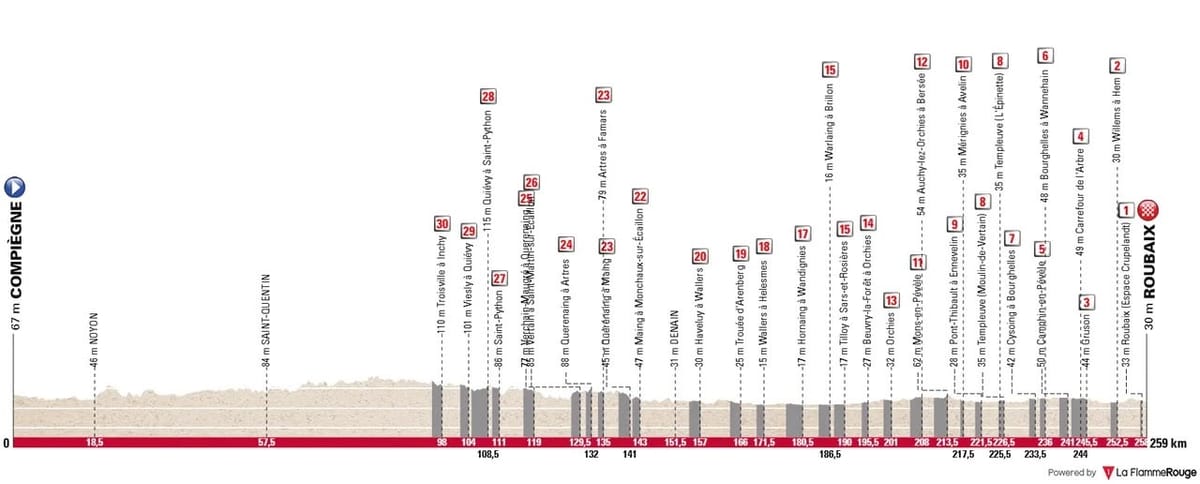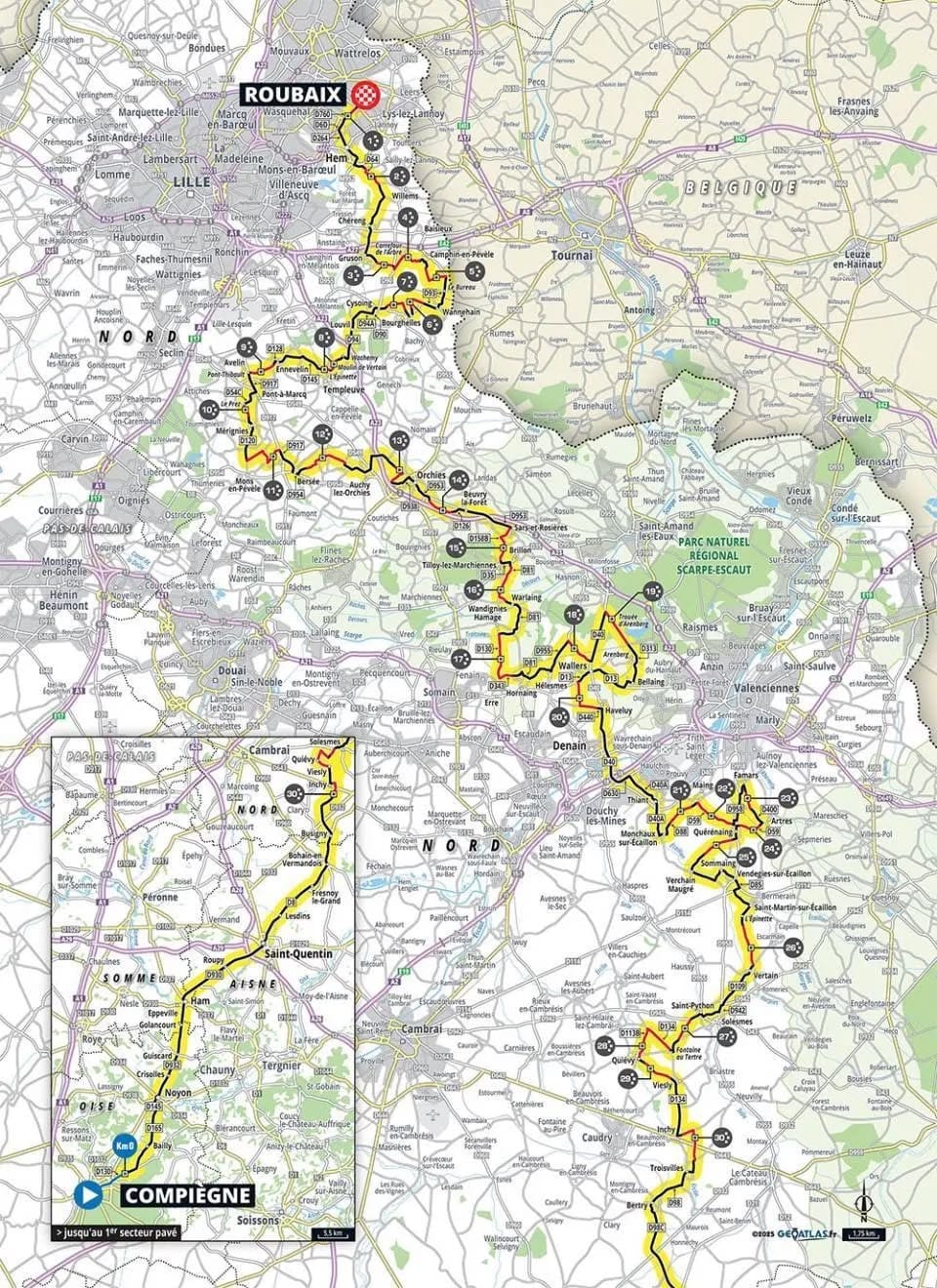Hell on Wheels: Your Ultimate Guide to the 2025 Paris-Roubaix
Get ready for the 2025 Paris-Roubaix! In-depth preview covering the brutal cobbled course, key favorites like Van der Poel & Pogačar, the weight debate & how to watch. (159 characters)

The air crackles with anticipation as the cycling world turns its eyes towards Northern France. On Sunday, April 13th, 2025, the peloton will confront one of the sport's most revered and feared challenges: Paris-Roubaix. Known affectionately and terrifyingly as the "Hell of the North" and the "Queen of the Classics," this third Monument of the season is more than just a race; it's a brutal test of skill, power, endurance, and luck, played out over treacherous cobblestone roads.
Following Mathieu van der Poel's dominant back-to-back victories in 2023 and 2024 – the latter a stunning 60km solo effort – the stage is set for another epic chapter. Can the Dutch superstar make it three in a row? Or will the debut of reigning World Champion Tadej Pogačar rewrite the script? With a slightly modified course and a field stacked with formidable contenders, the 2025 edition promises relentless drama.

The Legendary Battleground: The 2025 Course
Stretching 259.2 kilometers from its traditional start in Compiègne to the iconic finish on the Roubaix Velodrome, the parcours itself is a primary antagonist. While largely flat, its difficulty lies in the infamous pavé. This year, riders face 30 cobbled sectors, one more than in 2024, totalling a bone-jarring 55.7 kilometers.
The punishment begins after nearly 100 kilometers of racing, with the first sector from Troisvilles to Inchy (Sector 30, ***). The challenges arrive thick and fast, including the return of the Saint-Python sector (Sector 27, **) and an added degree of difficulty near Quérénaing with new sectors at Artres (Sectors 24 & 23). These early stages, combined with a likely brisk pace spurred by a forecasted tailwind, are designed to whittle down the peloton even before the most notorious sections appear.
As always, three five-star sectors stand out as potential race-deciding battlegrounds:
- Trouée d’Arenberg (Sector 19): Arriving 95.3km from the finish, this 2.3km straight trench of uniquely brutal cobbles is legendary. Entering it at speed is critical but perilous. For 2025, safety concerns have led to a revised approach. Instead of last year's sharp chicane, a small detour around the Arenberg mine site, featuring four right-angle bends in the preceding kilometer, aims to reduce the entry speed more smoothly.
- Mons-en-Pévèle (Sector 11): This demanding 3km sector comes with 48.6km remaining and often marks the beginning of the race's endgame. Its length and difficulty can shatter weary legs and expose weaknesses.
- Carrefour de l’Arbre (Sector 4): Just 17.1km from the velodrome, this 2.1km stretch is frequently the launchpad for decisive attacks. Its technical nature and proximity to the finish make it a critical flashpoint.
While these are the toughest, the cumulative effect of navigating all 30 sectors, from the four-star challenges of Quiévy à Saint-Python (Sector 28) and Hornaing à Wandignies (Sector 17) to the seemingly minor one-star Roubaix sector just before the velodrome, defines this race. It's a relentless accumulation of punishment.
2025 Paris-Roubaix Cobbled Sectors:
- Troisvilles à Inchy (163.4km to go) 2,200m – ***
- Viesly à Quiévy (156.9km) 1,800m – ***
- Quiévy à Saint-Python (154.3km) 3,700m – ****
- Saint-Python (149.6km) 1,500m – **
- Vertain à Saint-Martin-sur-Écaillon (142.5km) 2,300m – ***
- Verchain-Maugre à Quérénaing (131.2km) 1,600m – ***
- Artres à Quérénaing (128.3km) 1,300m – **
- Artres à Famars (125.4km) 1,200m ***
- Quérénaing à Maing (120.7km) 2,500m – ***
- Maing à Monchaux-sur-Écaillon (117.6km) 1,600m – ***
- Haveluy à Wallers (104.7km) 2,500m – ****
- Trouée d’Arenberg (95.3km) 2,300m – *****
- Wallers à Hélesmes (89.2km) 1,600m – ***
- Hornaing à Wandignies (82.5km) 3,700m – ****
- Warlaing à Brillon (75km) 2,400m – ***
- Tilloy à Sars-et-Rosières (71.5km) 2,400m – ****
- Beuvry à Orchies (65.2km) 1,400m – ***
- Orchies (60.1km) 1,700m – ***
- Auchy à Bersée (54km) 2,700m – ****
- Mons-en-Pévèle (48.6km) 3,000m – *****
- Mérignies à Avelin (42.6km) 700m – **
- Pont-Thibault à Ennevelin (39.2km) 1,400m – ***
- Templeuve (L’Épinette) (33.8km) 200m – * & Templeuve (Moulin-de-Vertain) (33.3km) 500m – **
- Cysoing à Bourghelles (26.8km) 1,300m – ***
- Bourghelles à Wannehain (24.3km) 1,100m – ***
- Camphin-en-Pévèle (19.9km) 1,800m – ****
- Carrefour de l’Arbre (17.1km) 2,100m – *****
- Gruson (14.8km) 1,100m – **
- Willems à Hem (8.2km) 1,400m – ***
- Roubaix (Espace Charles Crupelandt) (1.4km) 300m – *
The Titans: Van der Poel vs. Pogačar
All eyes will be on the two biggest stars. Mathieu van der Poel (Alpecin-Deceuninck) arrives as the two-time defending champion, seeking to join legends like Cancellara and Boonen with three wins. His cyclocross background provides an innate feel for the cobbles, allowing for economical power expenditure. His victories in 2023 and 2024 showcased his raw power and tactical nous. Despite suggestions he wasn't at his absolute peak during the recent Tour of Flanders (reportedly due to illness after E3 and a crash), a focused week of recovery should see him ready. Backed by a formidable team including Jasper Philipsen (runner-up the last two years and a lethal sprinter), Van der Poel remains the benchmark.
More videos from Pogačar Roubaix recon, as he rode not only Arenberg, but all the Paris Roubaix sectors. 😍 pic.twitter.com/up2shzPYn7
— Lukáš Ronald Lukács (@lucasaganronald) February 11, 2025
Then there's Tadej Pogačar (UAE Team Emirates XRG). The Slovenian phenomenon makes his highly anticipated Paris-Roubaix debut, driven by his quest to win all five Monuments. His stunning power, demonstrated again in the Tour of Flanders, confirms his sensational form. However, his participation sparks cycling's "heftiest debate": can his relatively light frame (around 66-67kg) withstand the unique demands of Roubaix?
Historically, Roubaix favored heavier, powerful riders capable of generating immense watts over the flat, brutal pavé. Commentators like former winner Matthew Hayman and Sep Vanmarcke initially pointed to Pogačar's weight as a potential disadvantage against the raw power of rivals like Van der Poel or Wout van Aert. However, a growing consensus, supported by figures like 1981 winner Bernard Hinault (himself a lighter rider) and 2004 winner Magnus Bäckstedt, suggests modern cycling technology might be leveling the playing field. Advances in frame compliance, wider rims, and fatter tires absorb more shock, potentially mitigating the disadvantage of a lighter build. Hinault emphasizes agility and bike handling as crucial, qualities Pogačar possesses in abundance. Furthermore, Pogačar's recent Strava KoMs during course reconnaissance suggest he's navigating the stones effectively. While he might not be able to blast rivals away purely on wattage on the flat cobbles as he does on climbs, his tactical acumen, bike handling skills, and the support of a strong UAE team (including past podium finishers Nils Politt and Florian Vermeersch) make him a profound threat. He'll likely need to forge a gap before the velodrome, as sprinting against specialists isn't his forte.
The Formidable Challengers
Beyond the headline duo, a host of riders possess the power and pedigree to conquer the Hell of the North:
- Wout van Aert (Visma | Lease a Bike): Many believe Roubaix is the Monument best suited to Van Aert's powerful 'diesel engine' style. Less reliant on explosive climbing than Flanders, the relentless pavé plays to his strengths. With second and third place finishes previously, and showing resurgent form, he remains a prime contender, especially if he avoids the bad luck (like his 2023 puncture) that has plagued him here. The team also includes former winner Dylan van Baarle.
- Mads Pedersen (Lidl-Trek): The Dane is in strong form and leads arguably the deepest classics squad. Roubaix's flat terrain suits him well. Alongside Jasper Stuyven and the powerful Jonathan Milan, Lidl-Trek possesses multiple cards to play.
- Filippo Ganna (INEOS Grenadiers): The multiple World time trial champion has the massive engine required for Roubaix. Less suited to the sharp climbs of Flanders, he thrives on sustained power output. If he avoids misfortune (which hampered him in 2023), his time trial prowess could be decisive, especially if he gets clear late. Teammate and European TT champion Joshua Tarling is another powerhouse, though less experienced here.
- Stefan Küng (Groupama-FDJ): Another formidable time trialist known for his ability to sustain high speeds over long distances. While lacking a top-tier sprint, his raw power makes him dangerous if given any daylight.
The Outsiders and Dark Horses
Paris-Roubaix is famously unpredictable, often rewarding opportunism and resilience. Keep an eye on:
- Team Strength: Alpecin (Vermeersch), UAE (Politt, Wellens), Visma (Van Baarle), Lidl-Trek (Stuyven, Milan), Red Bull-BORA-hansgrohe (Mick & Tim van Dijke, Jordi Meeus, Laurence Pithie), Uno-X Mobility (Søren Wærenskjold, Alexander Kristoff).
- Fast Finishers: Tim Merlier (Soudal Quick-Step), Jordi Meeus, potentially Biniam Girmay (Intermarché-Wanty) if they reach the velodrome in contention.
- Powerful Rouleurs: Laurenz Rex (Intermarché-Wanty), Mike Teunissen (XDS-Astana), Ivan Garcia Cortina (Movistar).
Luck, Tactics, and Weather: The Deciding Factors
Raw strength is essential, but Paris-Roubaix demands more. Luck plays an outsized role; a poorly timed puncture, crash, or mechanical failure can end a favorite's chances instantly. Team tactics are crucial – positioning riders before key sectors, protecting leaders, and infiltrating breakaways can be race-winning moves. The forecasted moderate tailwind suggests a fast race, potentially favouring aggressive tactics, while the chance of rain could make the already treacherous cobbles even slicker, adding another layer of unpredictability and potentially favouring riders with supreme bike handling skills.
How to Watch the Spectacle
Don't miss the drama unfold:
- Date: Sunday, April 13, 2025
- Start Time (approx): 11:10 CET / 5:10 AM EDT
- Estimated Finish Time (approx): 17:15 CET / 11:15 AM EDT
- Broadcasters (check local listings):
- USA: NBC Sports / Peacock, FloBikes (check specific rights)
- Canada: FloBikes
- UK: TNT Sports / Discovery+ / Eurosport
- Australia: SBS
- Europe: Eurosport / Discovery+ (various national broadcasters like Sporza, France TV, Rai Sport, NOS also carry it)
- (A VPN service may be required for viewing outside licensed regions)
Conclusion: Prepare for Pandemonium
The 2025 Paris-Roubaix is shaping up to be an unforgettable clash. Will Mathieu van der Poel cement his legacy with a third consecutive cobblestone trophy? Can Tadej Pogačar conquer the Hell of the North on his first attempt, defying conventional wisdom about weight and experience? Or will another powerhouse rider like Wout van Aert, Mads Pedersen, or Filippo Ganna seize their moment on the unforgiving pavé? One thing is certain: the Queen of the Classics will demand everything from its suitors, delivering pain, glory, and cycling drama at its finest.





